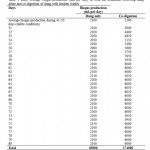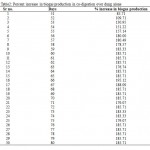Anaerobic Co-Digestion of Mixed Kitchen Wastes and Buffalo Dung
Pradip B. Acharya1 * and Prateek Shilpkar1
1
Biogas Research and Extension Centre and Department of Microbiology,
Gujarat Vidyapith,
Sadara District Gandhinagar,
Gujarat,
382320
India
DOI: http://dx.doi.org/10.12944/CWE.9.3.51
Copy the following to cite this article:
Acharya P. B, Shilpkar P. Anaerobic Co-Digestion of Mixed Kitchen Wastes and Buffalo Dung. Curr World Environ 2014;9 (3) DOI:http://dx.doi.org/10.12944/CWE.9.3.51
Copy the following to cite this URL:
Acharya P. B, Shilpkar P. Anaerobic Co-Digestion of Mixed Kitchen Wastes and Buffalo Dung. Curr World Environ 2014;9(3). Available from: http://www.cwejournal.org/?p=7609
Download article (pdf)
Citation Manager
Publish History
Select type of program for download
| Endnote EndNote format (Mac & Win) | |
| Reference Manager Ris format (Win only) | |
| Procite Ris format (Win only) | |
| Medlars Format | |
| RefWorks Format RefWorks format (Mac & Win) | |
| BibTex Format BibTex format (Mac & Win) |
Article Publishing History
| Received: | 2014-11-04 |
|---|---|
| Accepted: | 2014-11-22 |
A huge amount of plant and animal origin organic wastes are being generated daily throughout the world whose management is very difficult because improper management will produces foul odor and pollutants which causes an ill effect on health of living beings. Nature put microorganisms in almost everywhere which has potential to degrade them and utilize for their growth. Some microorganisms are aerobic whereas some are anaerobic and it was found by research that anaerobic digestion is superior to aerobic process because it requires low input cost, easy in operation and produces biogas also.1-4 The process was initially used to digest animal dung because it was available in huge amount. Slowly many plant and industrial wastes were tried successfully.5-7 Kitchen wastes can be used for biogas production.8 Present laboratory study was undertaken to find out the suitability of co-digestion of mixed kitchen wastes with buffalo dung for biogas production.
Materials and Methods
Buffalo dung was procured locally and mixed kitchen waste was collected from mess of our centre. This mixed kitchen wastes contains Bhakhri, cooked rice and boiled potato and they were mixed in the amount of 2.5 g, 5.0 g and 5.0 g. This mixed kitchen waste was mixed with 20.0 g dung to maintain 5.3% total solids concentration. A total of six digester sets of 5L were prepared each connected with one gas holder and water displacement bottle of 2 L. All the joints were made airtight and to fill the digesters up to 4.8 L in 40 days (Hydraulic Retention Time for Gujarat) 120 mL mixture of 40 or next 10 days. From 51st day when the biogas production becomes stable, three digesters were fed with mixture containing 20 g dung, 12.5 g mixed kitchen wastes and 87.5 mL water to maintain its total solids concentration to 5.3%. Remaining three digesters were fed by usual practice of 120 mL containing 40 g dung and 80 mL water. To maintain the level of feeding material inside the bottle 120mL digested slurry was taken out daily. Now the experiment was run for next 30 days and biogas production was measured daily.
Result and Discussion
Biogas production by dung alone in the digesters was 2100 mL per day on majority of days and fluctuates between 2050 and 2150 mL. During the whole experimental period of 80 days a total of 65000mL biogas was produced in it (Table 1). When a portion of dung was replaced by mixed kitchen wastes on 51st day then from the first day itself its positive effect on biogas production was observed which increased by 85.71% (Table 1, 2). With time this difference in biogas production between two treatments increased further and reached to a maximum of 195.12% in favor of co-digestion. During the whole experimental period a total of 174900 mL of biogas was produced in co-digestion treatment which was 2.69% higher than that of dung alone (Table 1). Since in this experiment all other conditions were kept same for both the treatments, hence the increase in biogas production in co-digestion may be due to increased bacterial activity only. We know that bacterial activity increased due to increased nutrients supply. Kitchen wastes contain more nutrients than dung and hence its addition supplied more nutrients to microorganisms. Higher biogas production in co-digestion of feeding materials was also reported previously. 9-11
 |
Table 1: Daily average biogas production (mL per day) in both the treatments receiving dung alone and co-digestion of dung with kitchen wastes Click here to View table |
 |
Table 2: Percent increase in biogas production in co-digestion over dung alone Click here to View table |
Conclusion
Results of the study show that kitchen wastes can be used along with buffalo dung for biogas production and their addition in said proportion resulted in 2.69% higher biogas.
Acknowledgement
We are hearty thankful to Prof. S.R. Dave, Head, Microbiology & Biotechnology Department, Gujarat University, Ahmedabad, Gujarat for providing continuous academic support and guiding to conduct this research successfully.
References
- Bouallagui H., Ben C.R., Marouani L. and Hamdi M., Bioresource Techn., 86, 85-89, (2003).
- Uemura S. and Harada H., Bioresource Techn., 72, 275-282, (2000).
- Gosavi P. G., Mirashi A.S., Waghmare A. S. and Singh R., J. Environ. Res. Develop., 4(3), 695-704, (2010).
- Milan Z., Sanchez E., Weiland P., Borja R., Martin A. and Ilangovan K., Bioresource Tech., 80, 37-43, (2001).
- Lastella, G., Testa, C., Cornacchia, G., Notornicola, M., Voltasio, F., and Sharma, V. K. Energy Convers. Manage, 43, 63–75 (2002).
- Gallert, C., Henning, A, and Winter, J. Water Res., 37, 1433–1441 (2003).
- Choi, D.W., Lee, W.G., Lim, S. J., Kim, B. J., Chang, H. N., and Chang, S. T. Biotechnol. Bioprocess Eng., 8, 23–31 (2003).
- Beno Z., Boran J., Houdkova L., Dalabaja T. and Sopnar J. Chem. Eng. Trans., 18, 677-682, (2009).
- Chellapandi, P., Prabaharan, D. and Laxmanan, U. EurAsian Journal of Biosciences, 2: 110-114, (2008)
- Amirhossein, M, Noor E, and Sharom, Z. Anaerobic co-digestion of kitchen waste and sewage sludge for producing biogas. In: 2nd International Conference on Environment Management, Bangi. (2004)
- Elijah, I, Lbifuro, M., and Yahaya, M. Scientific Research and Essays, 4 (9): 861-866 (2009).






